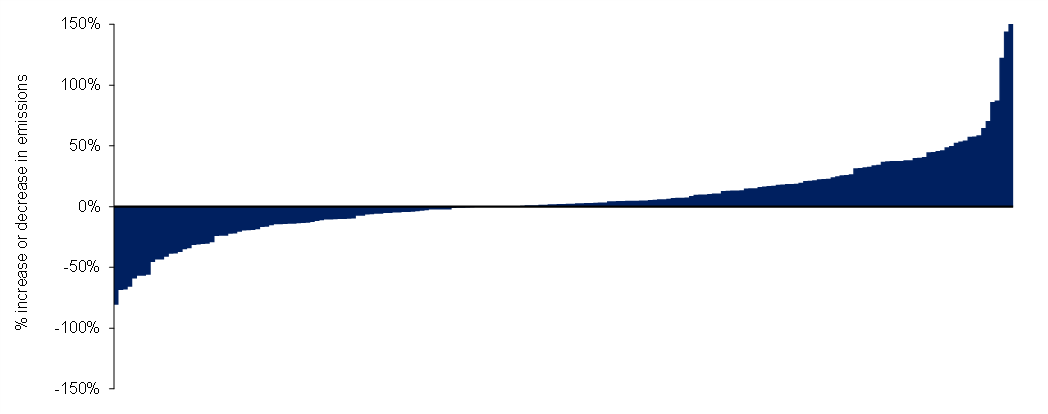
Australia’s central climate change policy tool is known as The Emissions Reduction Fund. Its objective is to help achieve Australia’s greenhouse gas emissions reduction targets.
The fund is administered by the Clean Energy Regulator and has three components:
- the issuing of Australian Carbon Credit Units (ACCU’s) for emissions reductions
- a process to purchase emissions reductions
- the Safeguard Mechanism.
The Safeguard Mechanism places a legislated obligation on Australia’s largest greenhouse gas emitters to keep net emissions below an agreed emissions baseline, for their highest emitting facilities.
Baselines are set with Australia’s emissions reduction targets in mind. The Safeguard Mechanism applies to facilities with direct scope 1 emissions of more than 100,000 tonnes of carbon dioxide equivalent (t CO2-e) per year, across a broad range of industry sectors, including electricity generation, mining, oil and gas, manufacturing, transport, construction and waste.
If Safeguard facilities exceed their baseline in a reporting period, they can:
-
Apply for a new baseline
-
Ask for a multi-year monitoring period (which allows a baseline to be exceeded one year as long as the average across 2-3 years is below baseline)
-
Apply for an ‘exceptional circumstances’ exemption
-
Surrender Australian carbon credit units (ACCUs) to offset the emissions over their baseline.
The current form of the Safeguard Mechanism appears to be ineffective. The Climate Council has claimed emissions from covered facilities have increased by 4%. The chart below shows the spread of emissions decreases and increases seen by the current facilities reporting under Safeguard (2020-21) since their first year of reporting.
|
Emissions movement across Safeguard facilities since first year of reporting |
|
Note: The below includes 192 of the 212 facilities currently reporting under Safeguard (2020-21). The remainder were excluded due to withheld emissions data, first year of reporting or being an extreme outlier. |
|
|
|
© 2022 Citigroup Inc. No redistribution without Citigroup’s written permission. |
|
Source: Citi Research, Clean Energy Regulator |
Prime Minister Anthony Albanese is committed to make a shift in energy policy, “end climate wars” and “take advantage of the opportunity for Australia to be a renewable energy superpower”. Besides the amendments to the Safeguard Mechanism, the Labor party has pledged to target 80% of the electricity mix be comprised of renewable energy by 2030, through their:
-
Rewiring the Nation policy: includes A$20 billion in new electricity transmission infrastructure.
-
Powering the Regions policy: investment in ultra-low cost solar banks (rolling out 85 across Australia), community batteries and improving energy efficiency in existing industries.
-
A National Reconstruction Fund, with $3 billion tagged to aiding industry’s low-carbon transition, including for manufacturing of green metals such as steel and aluminium; clean energy component manufacturing; hydrogen electrolysers and fuel switching; agricultural methane reduction and waste reduction.
-
A National electric vehicle strategy and lowered costs for electric vehicles. Labor has proposed removing taxes and duties on lower-cost electric vehicles. It has committed to 75% of all new Commonwealth fleet cars being low- or no-emissions by 2025.
-
To work with large businesses to provide greater transparency on their climate related risks and opportunities. This may include tougher disclosure laws and standardized company reporting, helping to bring Australia in line with international best practice, depending on how the conversations evolve.
-
Net-zero emissions in the federal public service by 2030
Who Owns Australia’s Safeguard Facilities?
-212 facilities reported under the Safeguard Mechanism in 2020-2021. Facilities with direct scope 1 emissions of more than 100,000 tonnes of carbon dioxide equivalent (t CO2-e) per year are required to report.
-72% of the Safeguard facilities have one sole owner. The remainder have split equity ownership between up to 6 different companies.
-120 companies own the facilities that report under Safeguard. This is measured by equity ownership. The Clean Energy Regulator requires a singular ‘responsible emitter’ to report the emissions of each facility annually. That is, the individual, body corporate, trust, corporation sole, body politic or local governing body that has operational control of the facility. However, being the ‘responsible emitter’ of a facility does not necessarily reflect equity ownership.
-86% of these facilities are owned by listed companies (in terms of equity), just over half of which are listed on the ASX. The remaining ~42% are listed on a mixture of international stock exchanges across seventeen different countries. US-based listed companies owning the second highest portion, following by Japan and Switzerland.
The full report goes on to sketch out a series of emissions scenarios and forecasts the implied carbon cost for companies under the Safeguard.
Read it here Australia & New Zealand ESG & SRI: Under Review: What’s the Carbon Cost of a Tightening Safeguard?
Citi Global Insights (CGI) is Citi’s premier non-independent thought leadership curation. It is not investment research; however, it may contain thematic content previously expressed in an Independent Research report. For the full CGI disclosure, click here.



